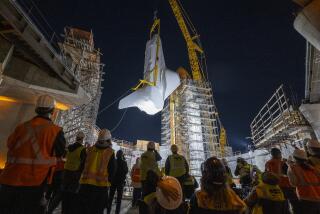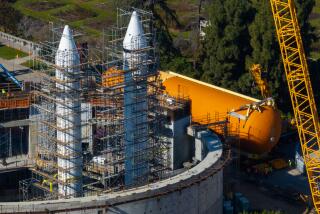Balky Satellite Returned to Shuttle Hold
- Share via
KENNEDY SPACE CENTER, Fla. — The space shuttle Endeavour’s astronauts hauled a troublesome satellite back aboard the spacecraft Thursday, ending an unfinished experiment aimed at producing semiconductor film in the pure vacuum of space.
The retrieval 250 miles above Earth was about the only thing that went well during the three days that the Wake Shield satellite flew free of Endeavour.
To Mission Control’s relief, the Wake Shield was stable as shuttle commander David Walker closed in for the capture. The 12-foot steel disk remained fairly steady even after he fired shuttle thrusters from distances of 290 feet and 200 feet to see how a free-flying object would react to such blasts.
Once the two spacecraft were within 35 feet, astronaut James Newman, operating the shuttle crane from inside Endeavour, seized the Wake Shield and tucked it into the cargo hold.
“We’re not clapping in the room. We’re howling,” Mission Control told the five astronauts, who call themselves the Dog Crew.
The $25-million satellite was plagued by overheating, tilting, wobbling, flipping and a undependable radio link.
Project director Alex Ignatiev said NASA still achieved the major objective: to produce semiconductor film on a free-flying satellite. The film was produced on the back of the Wake Shield, in the vacuum created in the satellite’s wake.
Even after the satellite was given an extra day of free flight, ground controllers managed to grow just four pieces of film on the satellite instead of the seven planned.
“There were some bumps in the road. We overcame most all of those bumps,” Ignatiev said.
Physicists won’t know how good the three-inch, super-thin wafers of film are for another month or two. If they prove superior to semiconductor film produced in vacuum chambers on Earth, space-created specimens eventually could lead to faster, more powerful computers.
More to Read
Sign up for Essential California
The most important California stories and recommendations in your inbox every morning.
You may occasionally receive promotional content from the Los Angeles Times.













